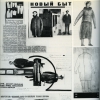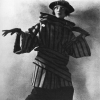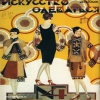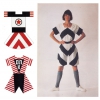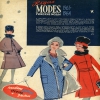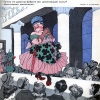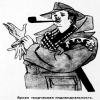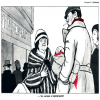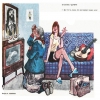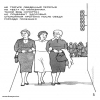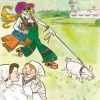

Fashion
|
In the period of the establishment of communist ideology and the short-term dawn of the Soviet New Economic Policy fashion went in two directions. On the one hand the construction of the costume has continued the tradition of pre-revolutionary period and focused on current trends in their highest manifestations. For example, in 1922, with trust "Moskvoshvey" opened a fashion studio, which was to be the coordinating center for theoretical modeling of the household suit and a prototype for fashion houses in the USSR. On the other hand, the new fashion was in the nature of experiments of VKhUTEMAS artists and students, under the idea of building a new life for a new proletarian society. This period is largely associated with the name of Nadezhda Lamanova and the first fashion magazines, which existed for a short time and soon were closed for lack of ideas. During this period fashion was first declared a relic of bourgeois taste, and the image of Soviet women was aligned with the words of Krupskaya, claiming that the Soviet woman - is primarily a worker and a mother. In 1930, during the period of the TsNIIShPa(institut ща seamstress) creation, private sewing workshops were abolished, and the ability to masters was tried to be redirected to the development of quite westernized wide cut suits and moderate fashion for women and children. This attempt of industrial becoming was cut short by the complex of the Great Patriotic War. After that, the Soviet fashion, having gone through a phase of clothes in the style of "city romance", made a desperate attempt to enter the international podium. How it happened at the World Exhibition Montreal 1967, when Tatiana Kozeeva from Kiev was elected "Miss Montreal," and her photo graced the covers of Canadian magazines. A short-term fashion for "Russian" swept through the world, while at home these esthetics came into conflict with the existing harsh ideology of proletarian style and production planning. Despite this, a brief renaissance in 1950 - 60th in the consumer sector gave the original products not only from fashion houses serving the nomenclature, but also consumer goods, backed up by the Soviet cinema beauties. "Cabins" (home life houses) started to play a leading role and the production of a working uniform. Posters urged to work more and spend less time running around shops. Work places make a requirement on the length of skirts; they were not supposed to be shorter than 10 cm from the knee. Area of the goods that are "non-essential" was gradually filled with goods of foreign production (the socialist camp and the capitalist), unevenly distributed, and gave rise to the legendary "deficit". Following the emergence of deficits began to gain momentum the black market trade and underground production of goods of acute consumption, which already in the 1970s drew long queues at department stores. The Soviet fashion publications and brochures from the fashion houses offered the admass conceptual patterns with parting words "Sew by yourself" or "Sewing by myself". As trendsetters in the fashion industry of the 70’s were trying to be representatives of the movie and music spheres. For example, such as Ludmila Zykina, constantly appearing in public in a Pavloposadsk shawl or Nikolay Eremenko Jr., after filming the movie "Pirates of the twentieth century," was referred to the status of Soviet macho in the early 1980s. But soon this trendsetting was washed out with the new foreign music boom. And in 1987 the Soviet space was invaded by the German magazine "Burda", which became the primary source of "Western fashion" in this period opening a string of beauties contest, but ... Even the abrupt change of course could not reverse the situation - it was late and in vain. The population sewed and knitted for years by the patterns from Polish and Soviet fashion publications, over 20 years of deficit of fashionable products sufficiently started doubting the slogan "The best – is the Soviet." Declared as a relic of bourgeois - fashion, distributed by black-marketers and the underground manufacturers increasingly won the minds of the Soviet people. Youth-music lovers boom and the emergence of the first co-operators, and “shuttles”, legally manufactured or brought from abroad, mass market clothing, completely destroyed the hopes that the Soviet factory production in the fashion industry will be able to catch up with the West. Cartoons on the mods, which appeared in the early 1950s and gave rise to the term "dude" in the 1970s and 1980s, gave way to an abundance of images with hippies and fashionable women from the "new wave". But all this pretentious mockery of taste and culture of the Western model of consumption did not cause one irony and failed to fulfill the assigned tasks. It did quite the contrary. |

